MSI B85M ECO Review: Aiming Green at $73
by Ian Cutress on November 26, 2014 8:00 AM EST- Posted in
- Motherboards
- MSI
- B85
- ECO
System Benchmarks
Power Consumption
Power consumption was tested on the system while in a single MSI GTX 770 Lightning GPU configuration with a wall meter connected to the OCZ 1250W power supply. This power supply is Gold rated, and as I am in the UK on a 230-240 V supply, leads to ~75% efficiency > 50W, and 90%+ efficiency at 250W, suitable for both idle and multi-GPU loading. This method of power reading allows us to compare the power management of the UEFI and the board to supply components with power under load, and includes typical PSU losses due to efficiency. These are the real world values that consumers may expect from a typical system (minus the monitor) using this motherboard.
While this method for power measurement may not be ideal, and you feel these numbers are not representative due to the high wattage power supply being used (we use the same PSU to remain consistent over a series of reviews, and the fact that some boards on our test bed get tested with three or four high powered GPUs), the important point to take away is the relationship between the numbers. These boards are all under the same conditions, and thus the differences between them should be easy to spot.
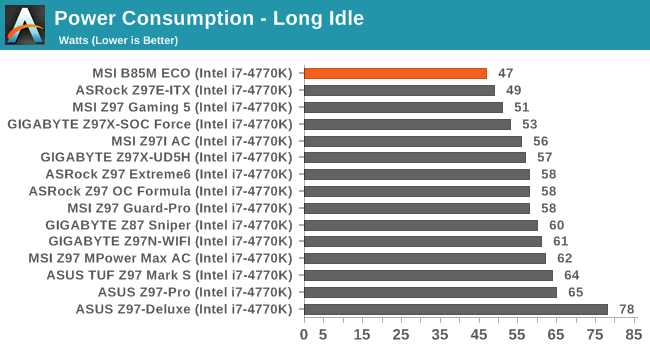
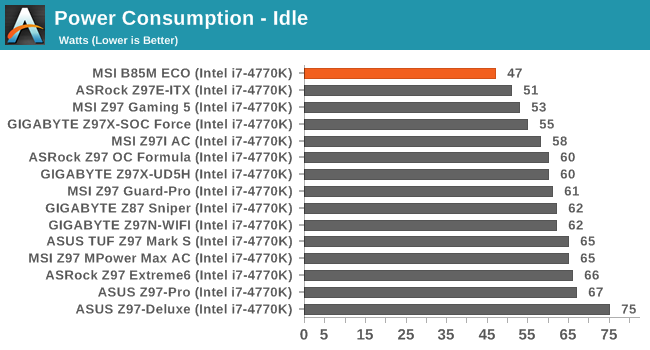
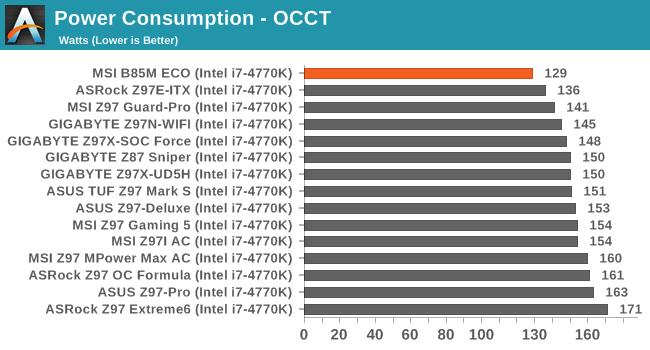
As mentioned previously in the review, when we set the B85M ECO up in the same test bed as our other Haswell-capable motherboards, it goes straight to the top of the list in long idle, idle and load power consumption.
For our 500W Platinum results on the B85M ECO, please refer back to the second page ‘Doing the Math on ECO’. For reference, with the i7-4770K on that power supply, we achieved 40W at long idle and 104W at peak loading.
Windows 7 POST Time
Different motherboards have different POST sequences before an operating system is initialized. A lot of this is dependent on the board itself, and POST boot time is determined by the controllers on board (and the sequence of how those extras are organized). As part of our testing, we look at the POST Boot Time using a stopwatch. This is the time from pressing the ON button on the computer to when Windows 7 starts loading. (We discount Windows loading as it is highly variable given Windows specific features.)
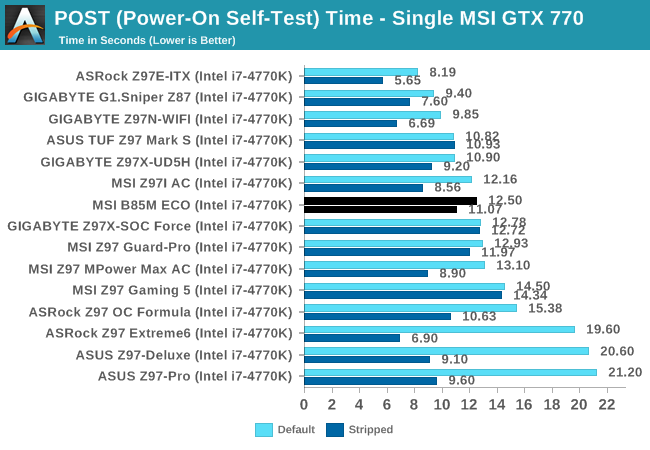
For a system that is heavily stripped, 12.5 seconds might seem like a long POST time. Bear in mind that that B85 is not particularly a platform for POST optimization, compared to the high average selling price market such as the OC Certified and Gaming ranges.
Rightmark Audio Analyzer 6.2.5
Rightmark:AA indicates how well the sound system is built and isolated from electrical interference (either internally or externally). For this test we connect the Line Out to the Line In using a short six inch 3.5mm to 3.5mm high-quality jack, turn the OS speaker volume to 100%, and run the Rightmark default test suite at 192 kHz, 24-bit. The OS is tuned to 192 kHz/24-bit input and output, and the Line-In volume is adjusted until we have the best RMAA value in the mini-pretest. We look specifically at the Dynamic Range of the audio codec used on board, as well as the Total Harmonic Distortion + Noise.

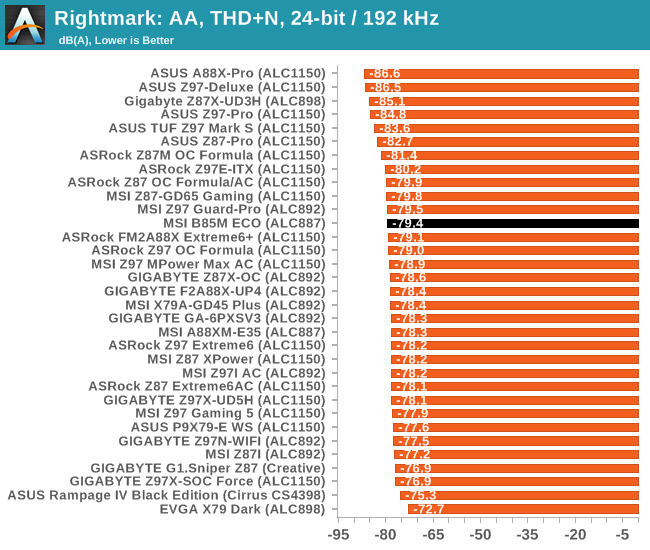
Using an ALC887 audio codec was never going to break any records for audio, but it does as well as can be expected.
USB Backup
For this benchmark, we transfer a set size of files from the SSD to the USB drive using DiskBench, which monitors the time taken to transfer. The files transferred are a 1.52 GB set of 2867 files across 320 folders – 95% of these files are small typical website files, and the rest (90% of the size) are small 30 second HD videos. In an update to pre-Z87 testing, we also run MaxCPU to load up one of the threads during the test which improves general performance up to 15% by causing all the internal pathways to run at full speed.

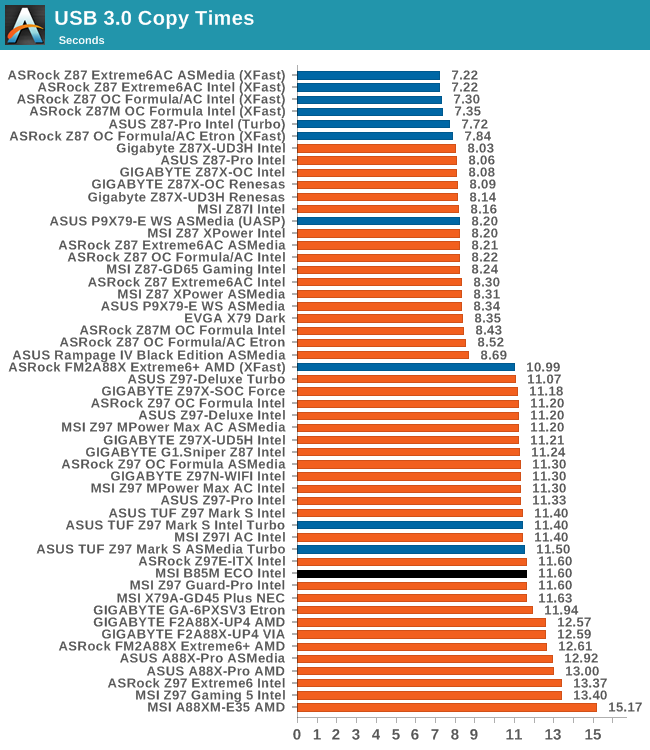
DPC Latency
Deferred Procedure Call latency is a way in which Windows handles interrupt servicing. In order to wait for a processor to acknowledge the request, the system will queue all interrupt requests by priority. Critical interrupts will be handled as soon as possible, whereas lesser priority requests such as audio will be further down the line. If the audio device requires data, it will have to wait until the request is processed before the buffer is filled.
If the device drivers of higher priority components in a system are poorly implemented, this can cause delays in request scheduling and process time. This can lead to an empty audio buffer and characteristic audible pauses, pops and clicks. The DPC latency checker measures how much time is taken processing DPCs from driver invocation. The lower the value will result in better audio transfer at smaller buffer sizes. Results are measured in microseconds.
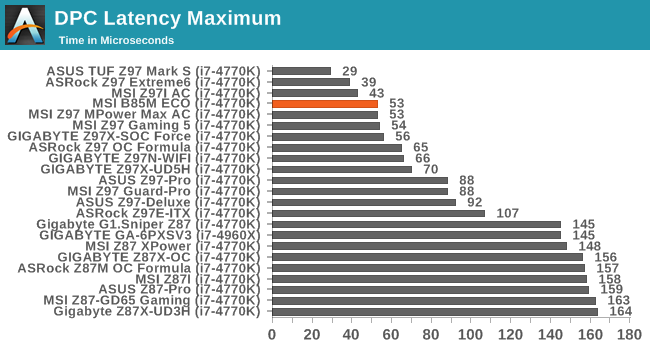
For whatever reason, I had in the back of my mind that an ECO-oriented board would not be that good in DPC Latency. I was greatly surprised when it achieved just over 50 microseconds and into the top part of our result list.










40 Comments
View All Comments
Cygni - Wednesday, November 26, 2014 - link
A Mini-ITX ECO would be right in my wheelhouse.I have an HTPC/NAS/Steam Mini-ITX thats on 24/7 and is several years old. It's next replacement cycle would likely last 5+ years, and the lowered power draw (plus lower heat) would be a no brainer over that lifetime. Could also see a market for personal servers and the like in Mini-ITX.
I would echo the request for undervolting access, even if its rarely worth it. The option would be appreciated to tinker with, if nothing else.
PaulJeff - Wednesday, November 26, 2014 - link
I think the point of these "eco" boards is determined by the economy of scale. For a real world example, you would need to replace dozens if not hundreds of workstations/desktops in an office to realize the true savings potential. If one workstations nets a few dollars a year in savings on power costs, multiply that by the number of workstations that will be replaced, multiply that by the # of years between hardware refresh cycles and that will add up the potential power savings.MSI should be selling this "ECO" brand to OEMs like Dell, HP, etc. and then the savings can be distributed on a mass market scale.
The cost delta between a non-ECO branded board and an ECO board is not worth it for SMB's and home users.
ultimatexbmc.com - Wednesday, November 26, 2014 - link
Good priceDaiz - Wednesday, November 26, 2014 - link
The price of electricity does not take into account the true cost of it's generation.It might be good to also consider the amount of fuel that is required or carbon output
for example 1kWh of electricity requires ~0.5kg of coal and produces ?? kg of carbon dioxide.
so assuming a 5 year upgrade cycle is going to happen no matter what, you are still stopping ~27.5kg of coal from being burned each year or 137.5kg over the life of the mobo. multiple by the number of machines in an office and every little bit helps.
Conficio - Wednesday, November 26, 2014 - link
Should the energy savings and cost savings not also include the cost for air conditioning/cooling? I know that server rooms care about that. So there should be at least some back of the envelope numbers which should increase the amount of savings somewhat.I'm just curious.
Lerianis - Thursday, November 27, 2014 - link
One thing I wanted to point out: 300 Watt power supply? Eh eh...... even a bargain basement, non-gaming intended dicrete graphics card needs 400 Watts minimum, unless it is the REALLY cheap ones sold to HP/Dell/Gateway for their office PC's.A regular person cannot even order one of those unless they go online and 'lie' to the HP parts person telling them "Yeah, my video card died and I want to replace it myself, can I order one of your replacement discrete graphics cards?"
400 Watts is a more realistic minimum for a system with a discrete graphics card, though with the new integrated graphics from Intel being able to push HD 1080p and 1920*1080 resolution other content without a stutter while using less than 2% of the CPU's power on an i5..... they might have an argument that no one needs a discrete graphics card who is not an uber-gamer anymore.
KAlmquist - Friday, November 28, 2014 - link
Actually, a 300 watt power supply should be enough to power a single GTX 980. However, Ian was presumably thinking about the standard business PC, which uses integrated graphics these days. As you correctly note in your last paragraph, the primary market for discrete graphics cards is now gamers.jtd871 - Thursday, December 4, 2014 - link
Ian,Thanks for reviewing a non-flagship board. Like others who have commented here, I could see something like this finding a home in a future personal build for productivity, light engineering and moderate gaming. And it's $25 to $50 less than the Z-series boards. Please, more like this in the uATX and mITX form factors!
Some feedback for MSI (and other board OEMs): ditch the (non-express) PCI already, please? Any business willing to buy enough of these isn't going to stick PCI add-in boards inside (assuming they can still find drivers for use with their modern operating systems). I would suggest eliminating the PCI slot altogether and keeping the x16 slot separated from the other 2 PCIe slots, as a lot of even low-end GPU cards (for business multi-monitor, say) are at least a double-slot width - rendering the 2nd slot unusable in those situations anyway, and make at least 1 of the remaining slots at least physically x8.
azazel1024 - Thursday, December 11, 2014 - link
This seems like a really stupid test of the power efficiency since that is the main focus. A REAL PSU, like a bronze or higher rated PSU in the 350-500w range should have been used. Either a standard B85, or H85/7 or something should have been compared to it. you have a board with an over abundance of features versus one bereft.Otherwise it is apples to oranges.
Also, if MSI's claims are accurate, the ECO frankly sucks. My Sever with a G1610 in it, H67, 8GB (2x4GB) G.Skill Sniper@1.2v, SSD, 2 HDDs plugged in and a pair of Intel Gigabit CT NICs and Antec Earth Watts 380 burned 21w at idle, drives spun down. The ENTIRE system uses less than what MSI claims a typical uATX boards uses at idle. Based on Intel's numbers for some things like the NICs, I have to assume that the board is using at MOST 15w and probably closer to 12w.
Seems like at most we are talking 2-3w of power savings MAYBE comapred to a VAGUELY similar board.
know of fence - Monday, March 2, 2015 - link
Being an enthusiast site AT always played down power consumption numbers. But just making assumptions and low balling 4 different variables (price, hours, efficiency, years of operation) is both cumbersome and somewhat disingenuous.A more elegant way would be to create a realistic range for those variables and combine them into coefficients for min, max and typical scenarios. You could even do typical US, typical EU, UK, India or whatever.
For me every 1 W saved 24/7 equals 2 EUR/annum, also 66 cent per Watt per year assuming 8 hours a day operation. Not to mention that PCs actually last anywhere from 5 to 10 years, though they are much less frequently used, once they are handed down to relatives.